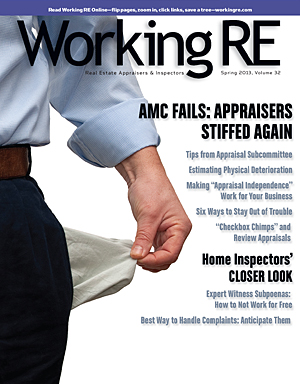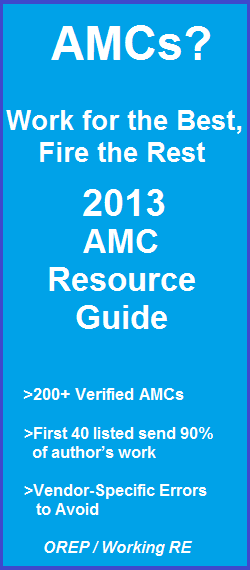
|
Published by OREP, E&O Insurance Experts | March 27, 2013 | Vol. 274 |
If we're going to survive, and eventually thrive again, we need to eliminate
"fuzzy math" from the vernacular when describing appraisal practice.
New Working RE magazine is in the mail now!
Editor’s Note: According to author Petkovski, technological advancements are unavoidable and can be of great benefit to appraisers, if they stand up and grab the reins.
Meteors, Appraisers and Change
by Jordan Petkovski
“Extinction is the rule. Survival is the exception.” ―
Carl Sagan
Seeing video of a meteorite streak through the sky over
Chelyabinsk, Russia recently got me thinking about the dinosaurs. Here one day,
and gone the next... If their cognitive abilities allowed for contemplative
thought, would they have feared “The End”? Would they have fought to survive in
the face of adversity or would they simply have accepted their fate?
Like the dinosaurs, our industry is inching closer to an E.L.E. (Extinction
Level Event), but instead of a rock hurtling towards an unknowing planet, our
E.L.E. will come in the form of outmoded practices that have failed to evolve in
concert with the ever changing landscape that makes up the mortgage lending
industry.
At this point, you may ask, “How do we prevent our own extinction?” The simple
answer isn’t simple at all. In fact, it will take a combination of actions,
including the adoption of objective methodological standards, and the continued
bridge-building between academic concepts and practical applications, if we are
to avoid going the way of the T-Rex.
Passion
As a hobby, I enjoy cooking (as well as eating!), so I spend a lot of time in
my kitchen when not contemplating the future of the appraisal industry.
As a result of my love of all things gastronomic, I do my best to seek out
renowned dining establishments during my travels.
Recently, I was presented with an opportunity to dine at
Incanto, the renowned and
award-winning restaurant helmed by Chris Cosentino (Top Chef Masters winner),
in San Francisco, Calif. As expected, the food was phenomenal and the
hospitality was noteworthy. Sitting at the Chef’s
counter, I had a view of the organized chaos that makes top-tier
restaurants so exciting. Every move the kitchen staff made was
purposeful, with little observable wasted effort. Though it may sound
clichéd, it was best described as poetry in motion.
The most unexpected aspect of this memorable dining experience was the
presence of the restaurant’s Chef Cosentino. Not only was Chef Cosentino
present, but was actually cooking! You may ask, “Is it so inconceivable
that a renowned chef would actually be found in their kitchen on a Tuesday
night?”, and my answer would be a resounding “Yes!”
At the end of our meal, I was lucky enough to chat with the Chef for a bit.
After expressing my gratitude for a memorable meal, I explained that it was an
unexpected surprise to see a chef of his stature working the line, when he
could easily delegate the responsibilities of his restaurant to one of his
many talented cooks. His response to my statement was so refreshing, I
have to recount it in this article, because it exemplifies the attitude that
each and every appraiser should embody. He said, and I’m paraphrasing,
“I need to be here, to be involved in order to ensure the restaurant continues
moving in the direction I want it to. I usually get to the farmers market
around eight in the morning, and I’m at the restaurant by 11 [am]. Then
I’m in the kitchen throughout service. This is my passion. This is
where I’m supposed to be.”
This culinary legend realizes the importance of participating in the process
day-in and day-out. He’s driven by his passion for his industry, and
obviously realizes that in order to achieve one’s goals and objectives, you
need to show up each and every day. The same passion and dedication
should be commonplace in the appraisal industry. We are all responsible
for the direction our industry takes. We ALL must exude passion
when proselytizing on behalf of our industry. If we’re absentee
practitioners, we shouldn’t show surprise when the profession devolves into a
group of glorified automatons, whose sole purpose is to verify that the home
does in fact exist (think 2075s all day, every day).
Fuzzy Math
I remember someone coining the term “fuzzy math.” The first time I
heard it, I thought to myself that it must have emanated from the mind of a
residential real estate appraiser. If we’re going to survive, and
eventually thrive again, we need to eliminate “fuzzy math” from the vernacular
when describing appraisal practice.
My peers and I see examples of “fuzzy math” more often than we’d like to
admit. The use of SWAG (a.k.a. Scientific Wild A*@ Guess) logic to
arrive at an adjustment for the difference between a two and three car garage
isn’t going to securitize the residential appraiser’s future. This is a
critical failure in today’s appraisal practice that can be solved with
relative ease. Data being as plentiful as it is, why don’t we have
simple – and in some cases, sophisticated – regression analysis as a systemic
part of our appraisal production process? If the average E*TRADE® user
can search through a plethora of analytics tools to assist them in making an
investment decision, shouldn’t appraisers have similar information available
to them?
Should consumers expect to see parity in appraisal findings, independent of
the appraiser engaged to complete the assignment? Are objective and
replicable development and reporting standards needed to survive the
forthcoming onslaught of more sophisticated automated valuation models?
For all of those playing along at home, I think the answer is self-evident.
Wish List
We need better analytics included in standard appraisal forms if we’re
ever going to close the gap between supposition and objective findings in the
residential appraisal world. I’d bet that users of appraisal reports would
like to see defined tolerances for line-item adjustments. I’m not a tech wiz
by any stretch of the imagination, but I find it hard to believe that we can’t
identify appropriate adjustments, within a range of tolerances, for almost
every aspect of comparison if using the right regression formula.
Appraisers need to realize technological advancements are unavoidable, and
could in fact benefit our industry if their development is controlled by
appraisal professionals, and their deployment is appraiser-centric.
Technology should be considered a tool in the appraiser’s arsenal, not a
cost-cutting measure that will eliminate the need for an appraiser’s market
knowledge. So who’s going to make it happen? Who’s going to demand more
from our technology partners? I ask that everyone reading this article
make it their mission to push this agenda, because without it, our fate may be
decided for us by those who hope to see appraisers supplanted solely by
technology. If WE don’t retain control of our destiny, WHO
will?
Irreconcilable Differences
The first thing we need to solve for are inconsistencies in appraisal
findings from appraiser to appraiser. I’d have retired many moons ago if
I had a nickel for every time I looked at two appraisals completed on the same
subject property, with the same effective date, and using the same dataset,
only to find reconciled values so far apart that you could pull a Carnival®
cruise ship through the difference. How do we bridge the gap between
subjective observations and objective - arithmetically derived - opinions of
value? We start by defining the contributory values associated with each
aspect of comparison, including a hierarchy of adjustments based on the nature
of the subject’s market area. For instance, in a market where value is
driven primarily by a subject property’s external site influences, like a
water attribute, it’s not difficult to ascertain adjustments. This relatively
simple equation, with most appraisers being well versed in how to use matched
pairs to conclude a dollar-per-front-foot adjustment for any water frontage on
a value contributing water attribute, is easily applied when the impact of a
single influence on value is so pronounced.
However, this task becomes increasingly more difficult as you run down the
list of potential adjustments because the impact of each dissimilarity becomes
less distinct between subject and comparable. In these less obvious
scenarios, doesn’t linear regression sound like a great option? But how
many appraisers are going to take the time to develop their own proprietary
formulas in an Excel spreadsheet? I’d guess fewer than we’d need to
positively impact the consumer’s confidence in our profession.
So we’ve determined that in today’s environment of shorter turn-times, anemic
fees and increasing demands placed on appraisers, future success will require
the development of more sophisticated tools to meet the needs of our intended
users. Today we need to fully understand and quantify the perceived
market reaction to differences between subject and comparable in real-time,
without having to spend hours on end sorting through piles of data. This
is the only way we can ensure our value-contribution to the mortgage lending
process isn’t overshadowed by the cost savings of using automation alone to
solve for the industries collateral valuation needs.
Problem Solved?
Unfortunately, this is only the starting point if meaningful change is our
objective. In the subsequent installments to this series, we’ll discuss
how to attract the next generation of appraisal professionals, and how they’ll
be trained, educated and certified. We’ll also delve into automated
population of appraisal form data-fields through integrations with public
records and MLS repositories. For now, I leave you with this... Ask
yourself what you can do to benefit the appraisal industry, and act upon your
answer!
About the Author
Jordan Petkovski is the VP/Chief Appraiser at Title Source.
>
Click to Print
this Article
ATTENTION: You are receiving WRE Online News because you opted in at WorkingRE.com or purchased E&O insurance from OREP. WRE Online News Edition provides news-oriented content twice a month. The content for WRE Special Offer Editions is provided by paid sponsors. If you no longer wish to receive these emails from Working RE, please use the link found at the bottom of this newsletter to be removed from our mailing list.




